Some of my favorite plants are late bloomers. Some of my favorite Scriptures talk about the last in equally wonderful terms. Sometimes, I think God saves the best for last.
John 2:7 Jesus said to the servants, “Fill the jars with water”; so they filled them to the brim. 8 Then he told them, “Now draw some out and take it to the master of the banquet.” They did so, 9 and the master of the banquet tasted the water that had been turned into wine. He did not realize where it had come from, though the servants who had drawn the water knew. Then he called the bridegroom aside 10 and said, “Everyone brings out the choice wine first and then the cheaper wine after the guests have had too much to drink; but you have saved the best till now.” 11 This, the first of his miraculous signs, Jesus performed at Cana in Galilee. He thus revealed his glory, and his disciples put their faith in him.
The last of the wine made for the first of the miracles. I don’t know whether it’s that most of my garden starts to look past its peak by October’s arrival and therefore, the late bloomers stand out. Or maybe it’s that as fall is in full swing and I know winter’s coming will put an end to the outdoor gardening, the late bloomers have a charm about them that brings joy to the heart. But maybe, the best is noticed more when it’s last. Hope springs eternal, but late fall bloomers say that little gardening miracles can still happen.
Just like the spring ephemerals, the late bloomers have a special charm. They dare to bloom in the face of the frost. They might not last as long as some of the summer staples, but they are stunning in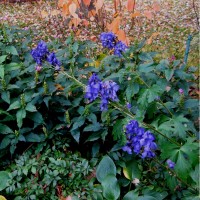 their season.
their season.
Here are a few of my favorites:
Aconitum (Monkshood)—Pictured on the right, Aconitum is a real showstopper displaying a brilliant cobalt blue color which is hard to come by in the perennial garden. For those of you who are concerned about such things, particularly cat owners whose cats eat plants, this plant is poisonous. I have this planted in a corner where its color pops in front of a serviceberry tree adorned with fall’s yellow-red leaves. It tolerates wet soil and shady conditions, making it a real winner in my book.
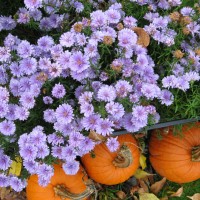 Asters—Asters (left) vary significantly in height and also in flower color. My garden features two different varieties which are among the latest to flower. Honey bees appreciate aster flowers for this reason.
Asters—Asters (left) vary significantly in height and also in flower color. My garden features two different varieties which are among the latest to flower. Honey bees appreciate aster flowers for this reason.
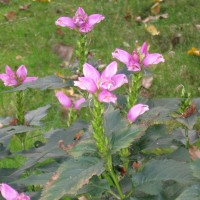 Chelone (Turtlehead)—Turtlehead (right) looks much like a tall snapdragon, but it is a perennial that tolerates wet soil and shade. These traits make it highly desirable along with its neat habit and colorful show. They are planted in a corner garden where their violet-red joins with blues and purples of other perennials to create a lovely harmonious look.
Chelone (Turtlehead)—Turtlehead (right) looks much like a tall snapdragon, but it is a perennial that tolerates wet soil and shade. These traits make it highly desirable along with its neat habit and colorful show. They are planted in a corner garden where their violet-red joins with blues and purples of other perennials to create a lovely harmonious look.
Chrysanthemum—Hardy chrysanthemums come in many colors and flower shapes. Some are cushion type, some are daisy type, but they are a staple of many fall gardens. They do tend toward being taller in the garden than they were at the garden center. To keep a bushy habit, they are best pinched back (the tips clipped off) before the 4th of July in order not to delay their bloom.
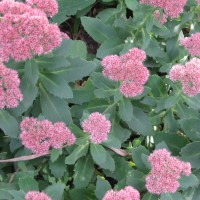 Sedum—This versatile perennial comes in upright and creeping plant growth habits, both of which are truly lovely. They are among the last to bloom and their flower color often deepens with the first frosts. Bees love this plant every bit as much as asters so careful plant placement will allow you to enjoy their beauty and allow
Sedum—This versatile perennial comes in upright and creeping plant growth habits, both of which are truly lovely. They are among the last to bloom and their flower color often deepens with the first frosts. Bees love this plant every bit as much as asters so careful plant placement will allow you to enjoy their beauty and allow 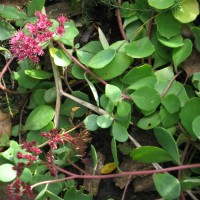 the honey bees to gather their end of season food without any unwelcome stinging. Sedums give their best flower color and exhibit optimal plant vigor in full sun, but they will tolerate part sun and will survive (albeit as spindly growth) in nearly full shade. I have a few divisions of “Neon” that I threw into the edge of the woods behind my house with the intent that they decompose and they’re surviving and flowering to spite me. It’s nice to know that while Sedum are fairly indestructible, they are versatile and beautiful too!
the honey bees to gather their end of season food without any unwelcome stinging. Sedums give their best flower color and exhibit optimal plant vigor in full sun, but they will tolerate part sun and will survive (albeit as spindly growth) in nearly full shade. I have a few divisions of “Neon” that I threw into the edge of the woods behind my house with the intent that they decompose and they’re surviving and flowering to spite me. It’s nice to know that while Sedum are fairly indestructible, they are versatile and beautiful too!
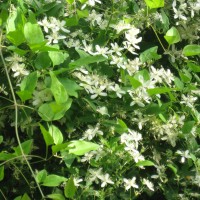 Sweet Autumn Clematis–Another bee-lover, this clematis (pictured left) is hardy and vigorous and produces a blizzard of blossoms in the fall. The vines themselves are rapid growers and given plenty of room to climb, they’ll fill a trellis, arbor, or fence with rambling beauty. I have planted them in two locations: one solo and also one interplanted along with some large flowered early summer blooming varieties so that my clematis bloom season is extended.
Sweet Autumn Clematis–Another bee-lover, this clematis (pictured left) is hardy and vigorous and produces a blizzard of blossoms in the fall. The vines themselves are rapid growers and given plenty of room to climb, they’ll fill a trellis, arbor, or fence with rambling beauty. I have planted them in two locations: one solo and also one interplanted along with some large flowered early summer blooming varieties so that my clematis bloom season is extended.
Japanese Anemone (right)—This is one of my most cherished of the late bloomers. Stately and elegant, the simple beauty of Japanese Anemone makes it a delight to everyone who sees it. Not a year goes by in which someone doesn’t ask me about this amazing white flower. The blossoms seem to flutter like butterflies in the wind due to the wiry stalks held high above the foliage. They are disease resistant and the pure white color goes with absolutely 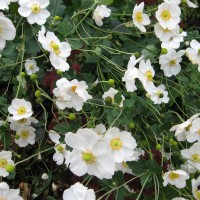 everything. They laugh in the face of early frosts and their cheerful appearance brightens the bleakest of drizzly fall days. They come in other colors, too, but in my opinion, nothing can beat the simplicity of this lovely late bloomer.
everything. They laugh in the face of early frosts and their cheerful appearance brightens the bleakest of drizzly fall days. They come in other colors, too, but in my opinion, nothing can beat the simplicity of this lovely late bloomer.
Yes, I believe that sometimes God saves the very best for last as a little glimpse of heaven–a reminder of hope to carry us through the winters of our lives.